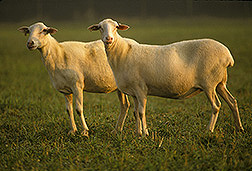Science Update
How Natural Pesticides Work
Over time, some weeds and fungi have developed resistance to many agricultural pesticides, creating a need to devise biologically based compounds—or biocides—with new modes of action. Organisms treated with pesticides respond by altering the transcription of their genes, most of which are expressed as proteins.
Different pesticides cause different transcription patterns, called transcription fingerprints, which can be documented and catalogued. Transcription is the first of two stages most genes undergo during the process of protein synthesis. After genetic information from DNA is transferred to messenger RNA (mRNA), the mRNA data is transferred to the protein during what is called translation.
Cutting-edge research is now under way to discern how natural fungicides and herbicides affect transcription fingerprints. Scientists are cataloging the effects of natural pesticides with different modes of action. Eventually, they will be assembled into gene transcription libraries for fungicides and for herbicides. These libraries will facilitate screening of new biocides and eventually be made available to the public.
Stephen O. Duke, USDA-ARS Natural Products Utilization Research Unit, Oxford, Mississippi; phone (662) 915-1036.
Online Training for Nutrition Educators
A new online training course has been developed by USDA’s National Agricultural Library specialists in collaboration with USDA’s Food and Nutrition Service. It’s intended for use by registered dietitians and others who work with USDA’s Special Supplemental Nutrition Program for Women, Infants, and Children.
The course comprises 4 lessons, each with 12 half-hour modules that provide basic introduction and background on a topic, along with tips for practical application in the clinic setting. It includes an online tutorial, a bookmark feature, job aids, and a certificate that can be printed. Approved as a self-study course by the American Dietetic Association’s Commission on Dietetic Registration, it provides a free, user-friendly, time-efficient method for staff development and continuing education.
Anyone can take this course by logging on to the site and creating a unique user name and password. Go to www.nal.usda.gov/wicworks/WIC_Learning_Online.
Len Carey, USDA-ARS National Agricultural Library, Beltsville, Maryland; phone (301) 504-5564.
Few intentionally introduced plant species escape cultivation, and even fewer become invasive pests. But having access to effective predictive models could reduce time and costs associated with quarantine programs designed to spot problem plants.
Models are under development that integrate the life history traits of 100 nonnative woody plants of the north-central United States with climatic and geographic risk analysis.
The researchers involved have modified an existing decision tree for assessing the risk of nonnative woody plants’ escaping anywhere in North America by introducing regionally important traits.
Their study incorporates knowledge about regional adaptation of trees and shrubs gained through 50 years of ornamental plant trials that have evaluated more than 600 accessions of woody landscape plants under a wide range of environments.
Mark Widrlechner, USDA-ARS North Central Plant Introduction Station, Ames, Iowa; phone (515) 294-3511.
|
|
To alleviate mineral deficiencies in sheep and goats, producers in other countries sometimes administer copper oxide wire particles to their animals. While such deficiencies may not exist here, a growing resistance of parasites to chemical dewormers has piqued interest in alternatives to conventional treatments for nematode infections.
Recently, researchers wondered whether copper supplements might also improve animals’ immune systems and create less desirable environments for parasites. So they tested the theory by administering varying amounts of copper wire as a bolus, in a soft mass of food, to control infections of barber pole worm, Haemonchus contortus, in hair sheep.
No signs of copper toxicity appeared at doses up to 6 grams. But the researchers found that as little as one-half gram of wire particles for at least 4 weeks resulted in a 60- to 90-percent reduction in nematodes.
Administering such small doses may allow more frequent treatments—especially during times of heightened need.
Joan M. Burke, USDA-ARS Dale Bumpers Small Farms Research Center, Booneville, Arkansas; phone (479) 675-3834.
"Science Update" was published in the June 2005 issue of Agricultural Research magazine.







